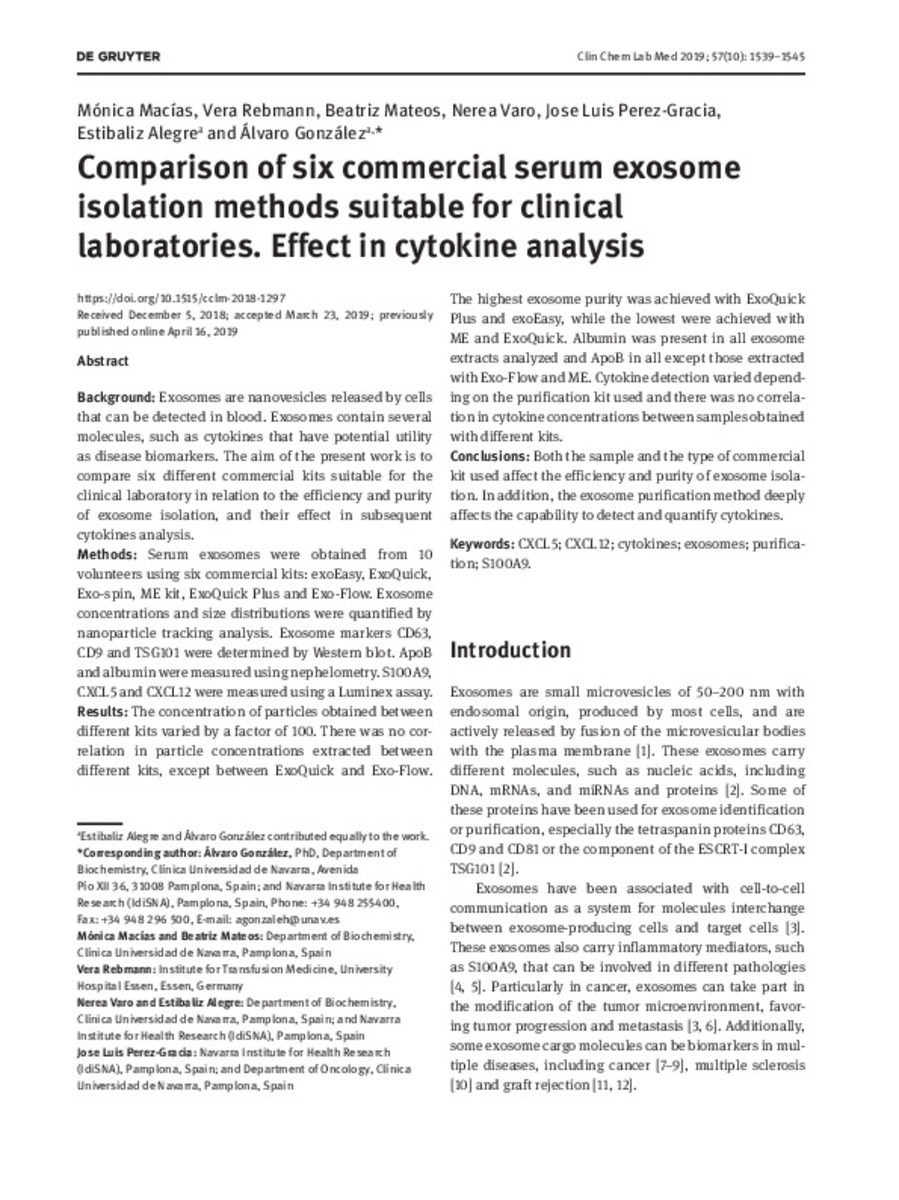Full metadata record
| DC Field | Value | Language |
|---|---|---|
| dc.creator | Gonzalez-Hernandez, A. (Alvaro) | - |
| dc.creator | Macías, M. (Mónica) | - |
| dc.creator | Mateos, B. (Beatriz) | - |
| dc.creator | Rebmann, V. (Vera) | - |
| dc.creator | Varo, N. (Nerea) | - |
| dc.creator | Alegre-Martinez, E. (Estibaliz) | - |
| dc.creator | Perez-García, J. (José) | - |
| dc.date.accessioned | 2024-01-16T12:56:47Z | - |
| dc.date.available | 2024-01-16T12:56:47Z | - |
| dc.date.issued | 2019 | - |
| dc.identifier.citation | Gonzalez-Hernandez, A. (Alvaro); Macías, M. (Mónica); Mateos, B. (Beatriz); et al. "Comparison of six commercial serum exosome isolation methods suitable for clinical laboratories. Effect in cytokine analysis". Clinical Chemistry and Laboratory Medicine (CCLM). 57 (10), 2019, 1539 - 1545 | es_ES |
| dc.identifier.uri | https://hdl.handle.net/10171/68375 | - |
| dc.description.abstract | Background: Exosomes are nanovesicles released by cells that can be detected in blood. Exosomes contain several molecules, such as cytokines that have potential utility as disease biomarkers. The aim of the present work is to compare six different commercial kits suitable for the clinical laboratory in relation to the efficiency and purity of exosome isolation, and their effect in subsequent cytokines analysis. Methods: Serum exosomes were obtained from 10 volunteers using six commercial kits: exoEasy, ExoQuick, Exo-spin, ME kit, ExoQuick Plus and Exo-Flow. Exosome concentrations and size distributions were quantified by nanoparticle tracking analysis. Exosome markers CD63, CD9 and TSG101 were determined by Western blot. ApoB and albumin were measured using nephelometry. S100A9, CXCL5 and CXCL12 were measured using a Luminex assay. Results: The concentration of particles obtained between different kits varied by a factor of 100. There was no correlation in particle concentrations extracted between different kits, except between ExoQuick and Exo-Flow. The highest exosome purity was achieved with ExoQuick Plus and exoEasy, while the lowest were achieved with ME and ExoQuick. Albumin was present in all exosome extracts analyzed and ApoB in all except those extracted with Exo-Flow and ME. Cytokine detection varied depending on the purification kit used and there was no correlation in cytokine concentrations between samples obtained with different kits. Conclusions: Both the sample and the type of commercial kit used affect the efficiency and purity of exosome isolation. In addition, the exosome purification method deeply affects the capability to detect and quantify cytokines. | es_ES |
| dc.description.sponsorship | Fondo de Investigación Sanitaria | es_ES |
| dc.language.iso | spa | es_ES |
| dc.relation | PI14/00274 | es_ES |
| dc.rights | info:eu-repo/semantics/openAccess | es_ES |
| dc.subject | CXCL5 | es_ES |
| dc.subject | CXCL12 | es_ES |
| dc.subject | Cytokines | es_ES |
| dc.subject | Exosomes | es_ES |
| dc.subject | Purification | es_ES |
| dc.subject | S100A9 | es_ES |
| dc.title | Comparison of six commercial serum exosome isolation methods suitable for clinical laboratories. Effect in cytokine analysis | es_ES |
| dc.type | info:eu-repo/semantics/article | es_ES |
| dadun.citation.endingPage | 1545 | es_ES |
| dadun.citation.number | 10 | es_ES |
| dadun.citation.publicationName | Clinical Chemistry and Laboratory Medicine (CCLM) | es_ES |
| dadun.citation.startingPage | 1539 | es_ES |
| dadun.citation.volume | 57 | es_ES |
Files in This Item:
Statistics and impact
Items in Dadun are protected by copyright, with all rights reserved, unless otherwise indicated.






